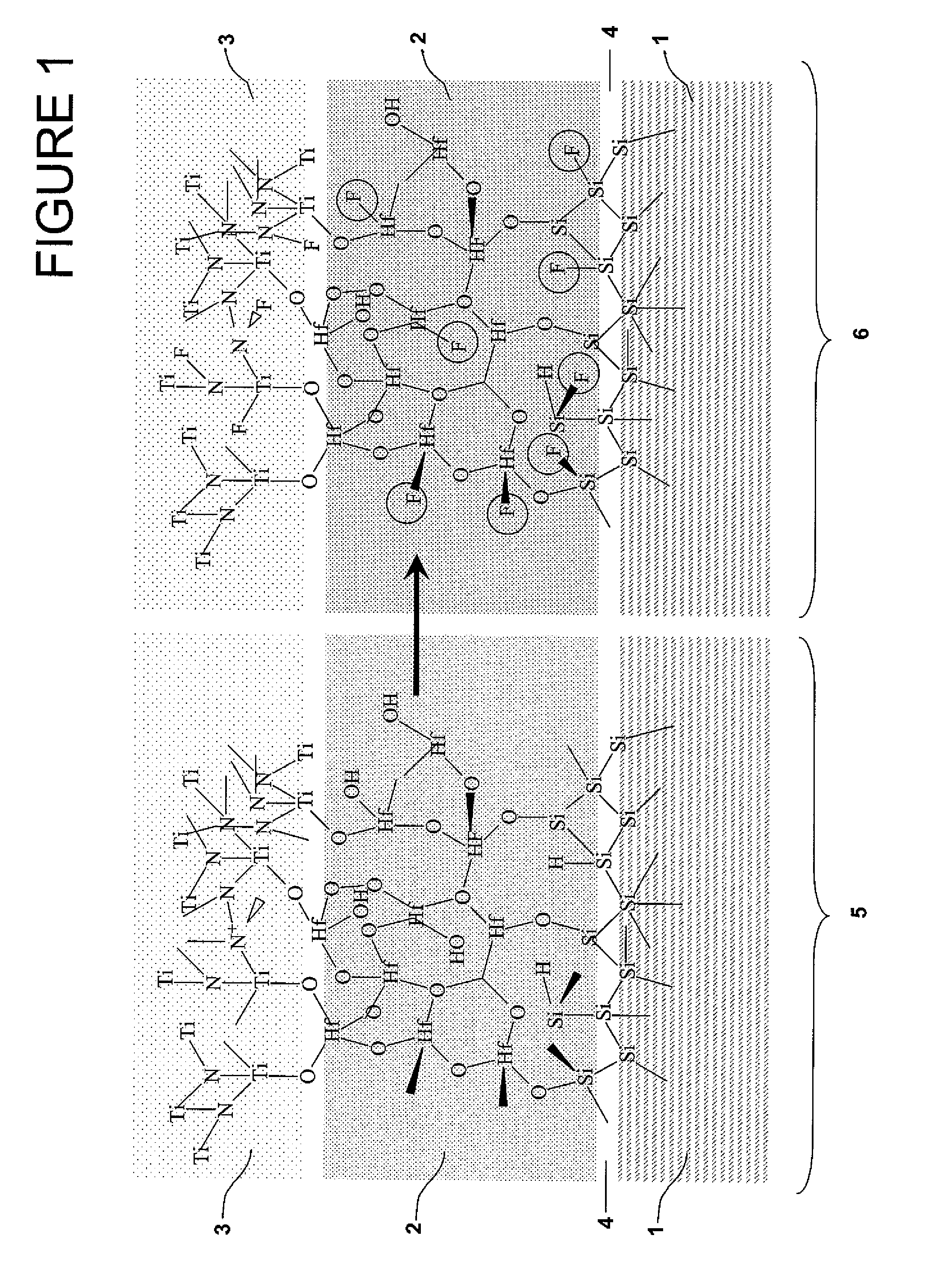Use of F-based gate etch to passivate the high-k/metal gate stack for deep submicron transistor technologies
a technology of deep submicron transistors and gate etching, which is applied in the direction of semiconductor devices, basic electric elements, electric devices, etc., can solve the problems of significant high amount of bulk defects and interface states, and the introduction of high-k and metal gate materials in scaled cmos technologies (45 nm nodes and beyond) faces significant difficulties, so as to increase the lifetime and performance of semiconductor devices.
- Summary
- Abstract
- Description
- Claims
- Application Information
AI Technical Summary
Benefits of technology
Problems solved by technology
Method used
Image
Examples
example 1
MuGFET Device Fabrication According to a Preferred Embodiment
[0131]MuGFET devices have been fabricated on standard [100] / [110] (top surface) SOI substrates with fin height Hfin=60 nm and fin widths down to 20 nm.
[0132]After fin patterning, the devices received a H2 anneal to smoothen the sidewalls and round the corners. The gate stack consists of a 5 nm ALD TiN layer on top of a 2 nm HfO2 / 1 nm SiO2 gate dielectric.
[0133]100 nm poly is used as a capping layer.
[0134]After gate stack deposition, an oxide hard mask (HM) is used to pattern the poly-silicon, stopping on the TiN layer.
[0135]For the TiN etch, BCl3 / Cl2 was used for the reference devices.
[0136]For the other devices, SF6 / O2 is used as gate-etch chemistry. The benefits of this chemistry are that it etches the TiN layer and at the same time introduces the necessary amount of F needed to passivate the interfaces of the high-k dielectric.
[0137]This method was demonstrated both for planar and MuGFET devices.
[0138]After gate pattern...
example 2
Gate Etch Processing and Transistor Performance
[0144]The metal gate etch processing is schematically depicted shown in FIG. 2. It is an isotropic etch and as consequence it has the same impact on all sides of the device.
[0145]During the TiN etch, F diffuses and accumulates in the hard mask (HM).
[0146]The thermal budget of the subsequent SEG step (750-810° C.) assists further diffusion of the accumulated F towards the dielectric interfaces. It also provides the necessary activation energy for passivating the interface states and / or for substituting the H atoms in the existing Si—H / Hf—H weaker bonds.
[0147]FIG. 3 shows the nFET and pFET saturation Vth versus gate length (LG).
[0148]An anomalous Vth behavior is seen for the reference devices (using no SF6 chemistry during the metal gate etch), a roll-up for nMOS and enhanced roll-off for pMOS). This behavior is typically attributed to process damage generated at the gate edges during device fabrication.
[0149]The SF6 / O2 devices do not exh...
example 3
Reliability Results in Devices Having Fluorine Incorporated in the Gate Dielectric
[0153]Interrupted stress (0.5 s delay) BTI measurements were performed at stress VG in the |1-2.2| V range and temperatures from 125 to 175° C.
[0154]The studied MuGFET devices (Wfin≦Hfin) have dimensions Wfin=20 nm, Hfin=60 nm, Nfins=30 (various LG). Planar devices (Wfin>>Hfin) have LG=Wfin=1 μm.
[0155]Si—F and Hf—F bonds have higher dissociation energies than Si—H and Hf—H, and are not broken during stress conditions similar or higher to typical operating conditions, such as temperature of 125-175° C. and electric fields (Eox) of 3-8 MV / cm (see FIG. 6).
[0156]FIG. 7 shows that the Eox, distribution in MuGFET and planar SOI devices is similar. As a consequence, the same Eox, evaluation method can be used in both cases.
[0157]FIG. 8 shows the NBTI lifetime improvement for devices having used a SF6 / O2 etch chemistry during metal gate etch (and additional selective epitaxial growth (SEG) as described above a...
PUM
 Login to View More
Login to View More Abstract
Description
Claims
Application Information
 Login to View More
Login to View More - R&D
- Intellectual Property
- Life Sciences
- Materials
- Tech Scout
- Unparalleled Data Quality
- Higher Quality Content
- 60% Fewer Hallucinations
Browse by: Latest US Patents, China's latest patents, Technical Efficacy Thesaurus, Application Domain, Technology Topic, Popular Technical Reports.
© 2025 PatSnap. All rights reserved.Legal|Privacy policy|Modern Slavery Act Transparency Statement|Sitemap|About US| Contact US: help@patsnap.com



